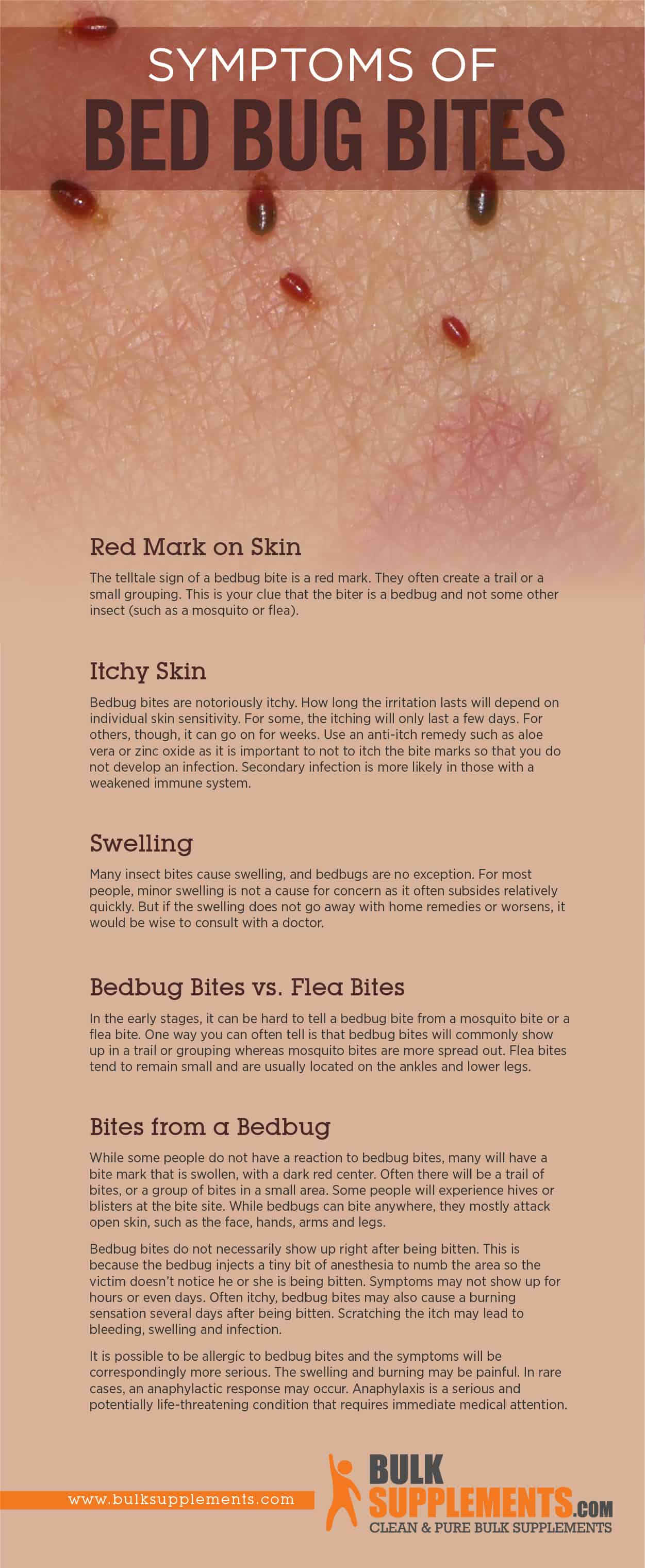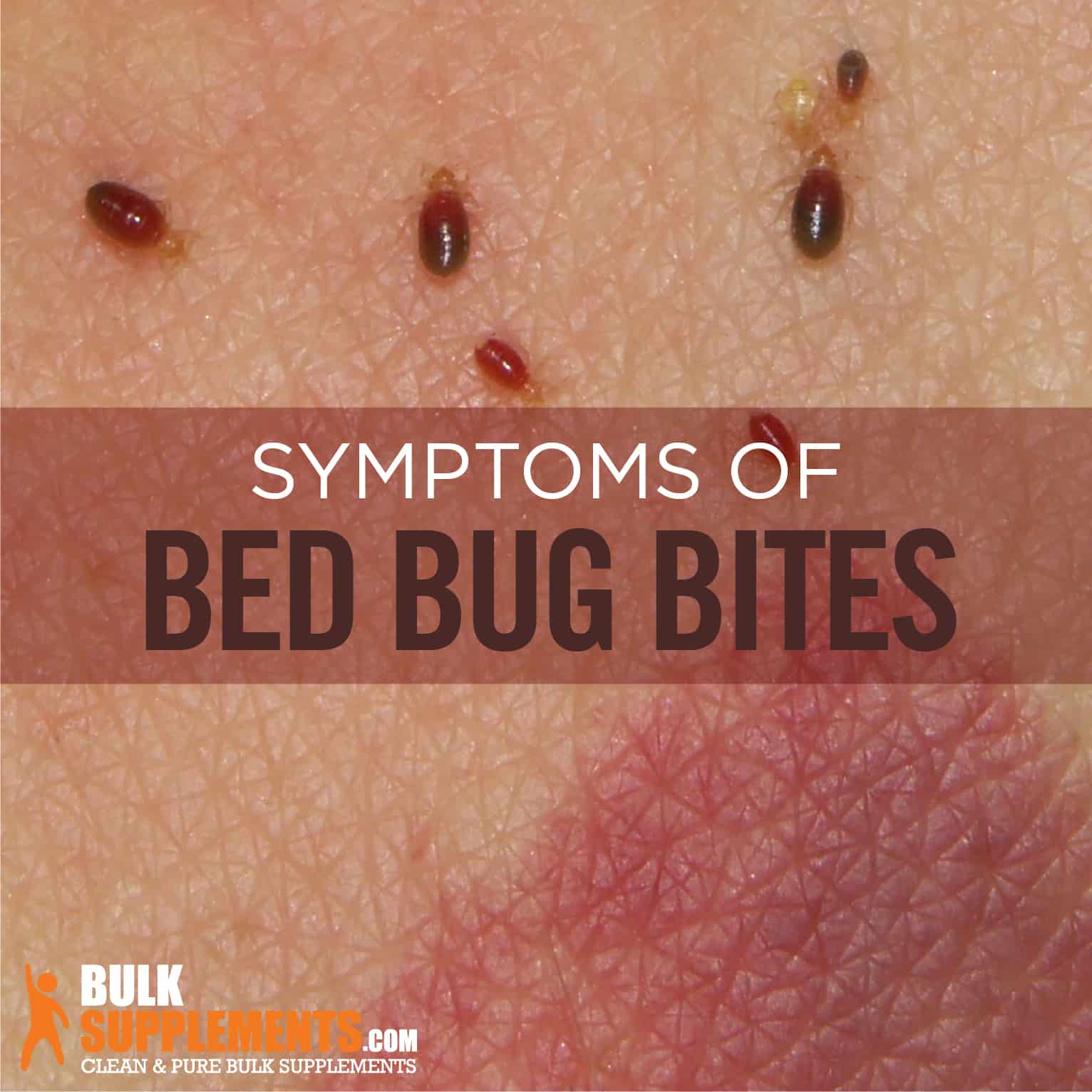What Are Bed Bug Bites?
Nighty-night
Sleep tight
Don’t let the bedbugs bite.
Catchy nighttime rhymes notwithstanding, bedbugs are anything but cute. Bed Bug bites are itchy, irritating and the bugs themselves can be difficult to get rid of. But you do have other options besides dousing yourself and your home with chemicals for taking care of both the bites and the bugs.
What Do Bedbugs Look Like?
Bedbugs are small insects (only 1-7 mm long), reddish-brown, wingless, flat and oval in shape. Adults are about the size of an apple seed. They feed on blood, human or animal, and use both people and animals to move from place to place. Bedbugs are nocturnal, feeding on their prey while they sleep.
Bedbugs are sneaky. They creep into your bed, sofa, even your rugs and then bite you while you sleep, leaving you with itchy, red welts the next morning.
Where Do They Come From?
Once rare, there has been a surge in the bedbug population in recent years. Bedbugs are most commonly found in places where there are many people in close quarters with a lot of turnover. Hotels, hospitals, college dorms, apartment buildings, business offices, military quarters and homeless shelters are all potential sources of bedbugs. However, since they can stow away on humans, animals and other things like luggage, it is possible to bring bedbugs into your home. Bedbugs breed quickly; females may lay up to five eggs each day.
Bedbugs do not need to eat every day (or night). They can go several days and even months without feeding. Therefore it may take some time to realize what is causing the problem. The good news is that bedbugs do not transmit diseases the way ticks and mosquitos do. The most common problem with bedbug bites is that the extreme itchiness may cause you to scratch, leading to infection. While bedbugs are annoying, they are not dangerous. The symptoms usually go away in a week or two, and an anti-itch cream can help keep you from scratching.
Bites from a Bedbug
While some people do not have a reaction to bed bug bites, many will have a bite mark that is swollen, with a dark red center. Often there will be a trail of bites, or a group of bites in a small area. Some people will experience hives or blisters at the bite site. While bedbugs can bite anywhere, they mostly attack open skin, such as the face, hands, arms and legs.
Bed bug bites do not necessarily show up right after being bitten. This is because the bedbug injects a tiny bit of anesthesia to numb the area so the victim doesn’t notice he or she is being bitten. Symptoms may not show up for hours or even days. Often itchy, bed bug bites may also cause a burning sensation several days after being bitten. Scratching the itch may lead to bleeding, swelling and infection.
It is possible to be allergic to bed bug bites and the symptoms will be correspondingly more serious. The swelling and burning may be painful. In rare cases, an anaphylactic response may occur. (x) Anaphylaxis is a serious and potentially life-threatening condition that requires immediate medical attention.
Bedbug Bites vs. Flea Bites
In the early stages, it can be hard to tell bed bug bites from a mosquito bite or a flea bite. One way you can often tell is that bedbug bites will commonly show up in a trail or grouping whereas mosquito bites are more spread out. Flea bites tend to remain small and are usually located on the ankles and lower legs (x).
How to Prevent Bedbugs
Many people prefer to avoid spraying insecticides and poisons inside the home, but there are some non-chemical options you can try. Bedbugs cannot survive extreme temperatures, either hot or cold, so steam-cleaning, washing clothes, pillowcases and other fabrics in hot water and drying on high heat are some home remedies you can use to remove bedbugs.
Steam can be very effective against bedbugs. The steam must exceed 140ºF (60ºC) in order to be effective. Do note that the fabric may be damp after steaming, but it should not be wet. Use fans to help dry the area. Repeat a few times for maximum effectiveness.
Freezing is another natural method of killing bedbugs. Place the item in the freezer (or outside if it is winter) for a minimum of two hours at a temperature below 1ºF (-17ºC).
Vacuuming can be another simple yet effective way to get rid of bedbugs. Any space that is the width of a credit card is big enough for a bedbug to hide in. Pay extra attention to seams, cracks and crevices. When you have vacuumed everything including luggage, carpets, furniture mattresses, etc., remove the vacuum bag, seal it, and dispose of it immediately (x).
Bed bug bites Symptoms
Red Mark on Skin
The telltale sign of a bedbug bite is a red mark. They often create a trail or a small grouping. This is your clue that the biter is a bedbug and not some other insect (such as a mosquito or flea).
Itchy Skin
Bedbug bites are notoriously itchy. How long the irritation lasts will depend on individual skin sensitivity. For some, the itching will only last a few days. For others, though, it can go on for weeks. Use an anti-itch remedy such as aloe vera or zinc oxide as it is important not to itch the bite marks so that you do not develop an infection. Secondary infection is more likely in those with a weakened immune system.
Swelling
Many insect bites cause swelling, and bedbugs are no exception. For most people, minor swelling is not a cause for concern as it often subsides relatively quickly. But if the swelling does not go away with home remedies or worsens, it would be wise to consult with a doctor (x).
Causes of Bed bug bites
Bedbugs live where you sleep, so search your bed, sofa or other sleeping quarters. High density, high turnover sleeping spaces such as hotels, apartments, military barracks and dormitories are famous for having bedbug issues. Bedbugs may hide in your mattress, box spring, bed frame, headboard, pillow, bed skirt, curtains or in carpets or other fabrics. Because they are so small, it can be difficult to see the bugs themselves, but you may see black dots that are their feces or red smears of blood.
Having bedbugs does not mean that you live in a dirty home. Begbugs can come into your home on luggage or used clothing, furniture and other common items. Prevention can be difficult if you travel regularly. If you do travel, bring a flashlight so you can inspect mattresses and furniture for signs of bedbugs, vacuum all your luggage thoroughly when you return home and wash your clothing in hot water.

Bed bug bites Remedies and Supplements
Some supplements to remove and/or prevent bedbugs include a bug spray of lavender oil or tea tree oil. You may also sprinkle diatomaceous earth powder into cracks and crevices where bedbugs like to hide.
Aloe Vera and Zinc Oxide
Aloe vera has antiseptic properties that soothe and heal. For instant relief, apply gel to the bite. Allow it to dry on the skin. It will protect and heal the irritated area. Zinc oxide is also a common ingredient in calamine lotion and other ointments that treat and heal rashes (x, x).
Cinnamon
Cinnamon is an effective anti-inflammatory, antibacterial and analgesic, making it an excellent natural remedy for bug bites. Make a paste out of ground cinnamon and water and mix well. Apply paste to the bite, cover with a bandage and let dry. Reapply as needed throughout the day (x).
Witch Hazel
Witch hazel contains anti-inflammatory properties and is an astringent that will soothe bug bites and irritated skin. Soak a cotton ball with witch hazel and apply directly to bite. Repeat as needed. You can also make a bug repellent spray with 2 tablespoons of witch hazel, 3-4 drops of cinnamon essential oil and 1 cup of water. Mix in a spray bottle and shake before applying. Spray directly on the skin at night to repel bedbugs (x).
Apple Cider Vinegar
Apple cider vinegar contains powerful anti-inflammatory and antimicrobial properties, making it useful in many different applications. It reduces redness and inflammation, as well as promotes healing. It will also reduce the risk of infection. If you do not have vinegar, lemon juice will also work. Soak a cotton ball with unfiltered, raw apple cider vinegar or lemon juice and apply directly to bites. It may sting at first. Keep it on for 5-10 minutes, then rinse off. You may reapply after 5-7 hours if you still need relief.
Toothpaste
Toothpaste is another old standby for bug bites. Choose a peppermint-flavored type if available as the menthol acts as an anesthetic. It will numb the pain, and reduce itchiness and swelling. Simply squeeze a dab on affected area. Leave on for 10 minutes then rinse off. You may also let the paste dry on the bite for longer-lasting relief from itching and swelling. Repeat as needed. Be sure to use white toothpaste only. Gel types are not effective.
Baking Soda
Baking soda’s alkalinity neutralizes the acid in insect bites. It also has anti-inflammatory properties that can reduce swelling and redness. Make a paste out of 2 teaspoons of baking soda and 4 teaspoons of water. Mix until it forms a smooth, runny paste. Apply to bites and leave on for 10 minutes. Rinse and pat skin dry. Can be reapplied after 45 minutes.
Rubbing Alcohol
Rubbing alcohol can be also used to repel bedbugs, thereby avoiding new bites. Simply soak a cotton ball and rub it on exposed areas of skin. You can also spray rubbing alcohol on your sheets, mattresses, pillows and even the bed. Do not smoke in bed after doing this or light any candles, as alcohol is highly flammable.
The Bottom Line
Bedbug bites are a nuisance, but bedbugs do not transmit other diseases. Since very few people are allergic to bedbugs, the bites can easily be treated at home with simple remedies such as aloe vera, apple cider vinegar or cinnamon.


